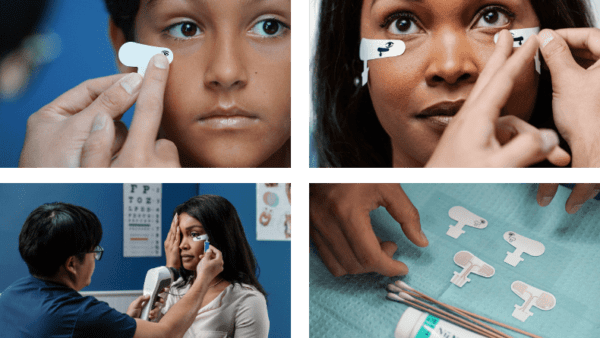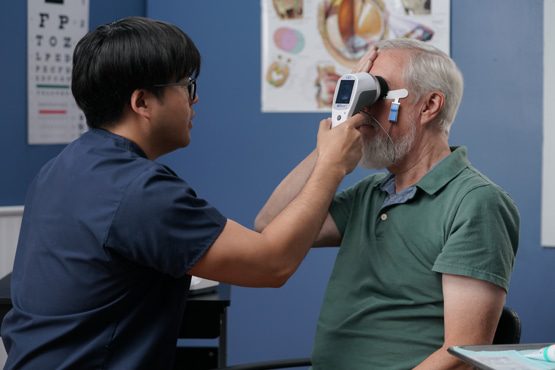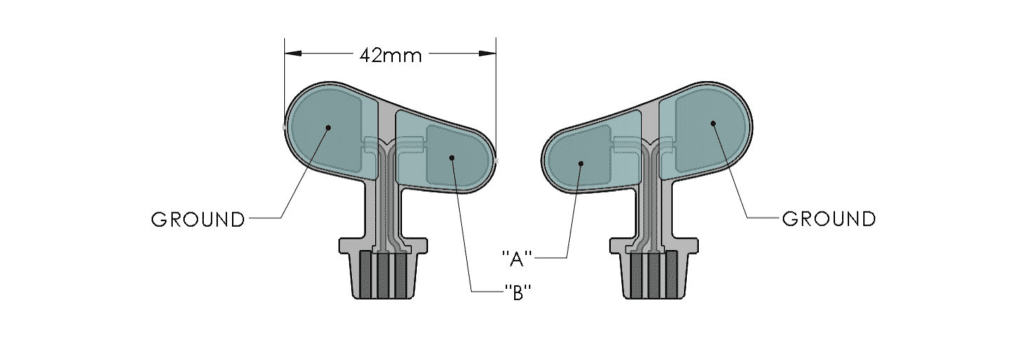
COMFORTABLE, CONVENIENT TESTING WITH RELIABLE RESULTS
Sensor Strips
Our patented, FDA-cleared Sensor Strip adhesive skin electrodes eliminate the need for corneal contact during ERG testing. Get the complete assessment of retinal health with enhanced patient comfort to generate consistent, objective results.

Benefits for Clinicians
- Consistent for clinical use – single strip design reduces placement variability
- Reduces prep time – 2 strips, 1 clip for efficient test set-up
- Easily connects to any ERG device

Benefits for Patients
- No corneal contact required – perfect for patients who cannot tolerate traditional corneal electrodes
- Flexible adhesive material enhances comfort and moves with the patient, preventing chances of electrode or cable pulling off
- Two size options for easier fit, even for patients with the smallest faces
- Consistent results reduce need for repeat testing, saving patients time or reducing additional appointments
BACKED BY SCIENCE
Validated by 13 Peer-Reviewed Studies
Our patented Sensor Strips enhance patient comfort for consistent, reliable results – and you can rest easy knowing that this innovative electrode technology has been validated by 13 peer-reviewed studies with more than 600 patients.

Sensor Strips with the RETeval manual y portátil,
El dispositivo ERG/PEV portátil RETeval® handheld ERG and innovative skin electrodes allow for consistent, reliable assessment of retina function.
The device allows clinicians to perform ERGs more quickly, easily, and accurately, with patient comfort in mind. Eye care providers can help their patients better manage disease with functional assessment and objective data. With our age-matched reference database of healthy retina function and color-coded reporting, interpreting ERG results has never been easier.
“Sensor Strips by LKC really work great. Patients LOVE them. I don’t have to subject them to the discomfort of the scleral lenses or the DTLs.”

Regular-sized Sensor Strips

Our patented noninvasive adhesive skin electrodes improve patient comfort and shorten set-up time for ISCEV-compliant ERG testing with any device. Generate reliable, repeatable results for photopic and scotopic or dark-adapted ERG testing protocols without corneal contact to streamline assessment protocols and better manage disease.

Small-sized Sensor Strips

At 2/3 the size of our regular strips, these small Sensor Strips are ideal for pediatric use or for any patient with a smaller face. These flexible adhesive electrodes move with the patient and are simple to place, allowing consistent, sensitive functional assessment of retinal health for patients of all ages. Read more about the RETeval device in pediatrics.

Compare Sensor Strips to Other ERG Skin Electrodes
| Feature | Sensor Strips by LKC | Other Skin Electrodes |
|---|---|---|
| Electrode Placement | All three electrodes in one strip | All three electrodes have to be individually placed, taking more time and adding variability as the spacing between the electrodes can change |
| Electrode Connection | All connections done with one connector | Multiple connectors required |
| Connector Cable | Designed to slip off if cable is pulled so skin is not impacted | Locking connector cable, more likely to pull the skin |
| Preparation Time | No skin prep is needed for flicker tests. Single flash tests benefit from NuPrep or alcohol wipes. | Must prepare skin area under eye, on side of head, and forehead for connectors |
| Adherence to Skin | Soft gel pads adhere directly to skin | Lid sensor and tape liner required |
| Skin Placement | Torsion-relief feature reduces chance of connector of cable pulling off of the skin due to patient movement or environmental factors | No torsion-relief, electrode more likely to pull the skin |
| Patient Eye Comfort | Placed 2 mm below eye for maximum comfort | Must be placed directly under lower eyelash |
More about the RETeval ERG/VEP device
Popular Topics: Make a Difference in Diabetic Retinopathy Care | Glaucoma Evaluation with RETeval PhNR Test | RETeval Device Reference Data | RETeval in Optometry
Case Studies: ERG Demonstrates Stable Function Despite Severe Structural Damage | ERG Supports Treatment Decision in Diabetic Retinopathy | Photopic Negative Response as a Reliable Method for Glaucoma Follow-up in Children | A Tale of Two Patients | Vision Complaints Reflected on ERG | Predictive Value of Combining Diagnostic Technologies| ERG Provides Clarity When Fields and OCT Are Inconclusive| ERG Raises Red Flag, Changing Management Trajectory | ERG Provides Confidence to Monitor or Treat | ERG to Determine Ischemic Status | ERG to Replace FA for CRVO Treatment Decision | Using ERG to Monitor Glaucoma | Routine ERG Use Supports Complex Patient Management | ERG Alters Follow-up Schedule and Education for Patient with Diabetes | Using ERG for Management of Birdshot Chorioretinopathy | Using ERG to Monitor Glaucoma | Comprehensive Pediatric Assessment Using ERG in Challenging Cases | ERG Above and Beyond Retinal Imaging | ERG’s Role in Diabetic Retinopathy Progression Monitoring | Evaluación de riesgos basada en ERG en CRVO | ERG Supports Diagnostic Accuracy in a Pediatric Patient
Ebooks: Core Cases from the Clinical Compendium | Modern Fundamentals of Diabetic Retinopathy Management in Optometry | Elevating Patient Care with ERG
Articles: Electroretinography Added to AAO’s Diabetic Retinopathy Preferred Practice Pattern Guidelines | ¿Es cómodo el dispositivo RETeval para los pacientes? |The Use of RETeval ERG/VEP en oftalmología pediátrica | How RETeval ERG Has Enhanced My Practice | The Use of RETeval ERG/VEP in Pediatric Ophthalmology | The Ultimate Guide to Diabetic Retinopathy in Primary Eyecare | What Type of Functional Testing Do You Prefer for Patients with Diabetes? | Major Milestone: RETeval Referenced in over 200 Publications | Collaboration to Elevate the Standard of Care for DR | Is ERG Needed if You Have Access to a Good Structural Imaging Device? | UN ENFOQUE SENCILLO PARA EL MANEJO Y APOYO DE LOS PACIENTES CON DIABETES | Simplify Grading and Risk Assessment in Diabetic Retinopathy | Simplify Daily Decision-Making with Modern ERG | Objective Functional Testing Needs in Diabetes and Glaucoma | Why Modern ERG is Re-Defining Diabetes Management | Diabetic Retinopathy Management Protocols for Optometry
Videos: RETeval: More Information, Better Decisions | RETeval: Eliminating Confusion in Clinic | RETeval: Function to Rely On | RETeval Handheld ERG: Features & Benefits | RETeval: Enhancing Collaborative Care | Handheld ERG for Primary Eyecare | Advice for Optometric Colleagues about Handheld ERG | Making a Difference in Diabetic Retinopathy Care | Changing the Way We Think About Electrodiagnostics | ERG Testing Made Simple | VEP Testing Made Simple | ERG Waveform | Introduction to Visual Electrophysiology | A Superior DR Progression Risk Assessment with the RETeval manual y portátil, | Improve Glaucoma Management with the RETeval Handheld ERG Device | Reshaping the Retinal Diagnostic Landscape | New Solutions for Infants with ROP | Using the RETeval in Myopia Research
Webinars: ABCs of ERG | Ready for RETeval | ERG in Action | Blueprint for Functional Assessments | Predicting Vision Loss in a Busy Retina Practice | Objective, Functional Testing for Glaucoma? | Best Management Practices for Diabetic Retinopathy | How the RETeval Device Became a Daily Instrument in my Diagnostic Toolkit
¡Hablemos!
Solicite una demostración o más información sobre nuestros dispositivos.
